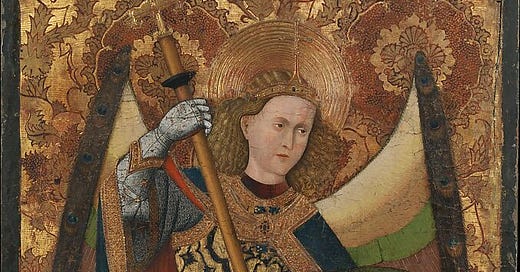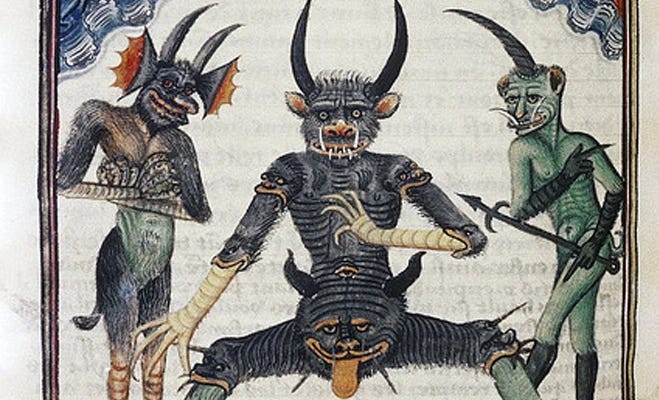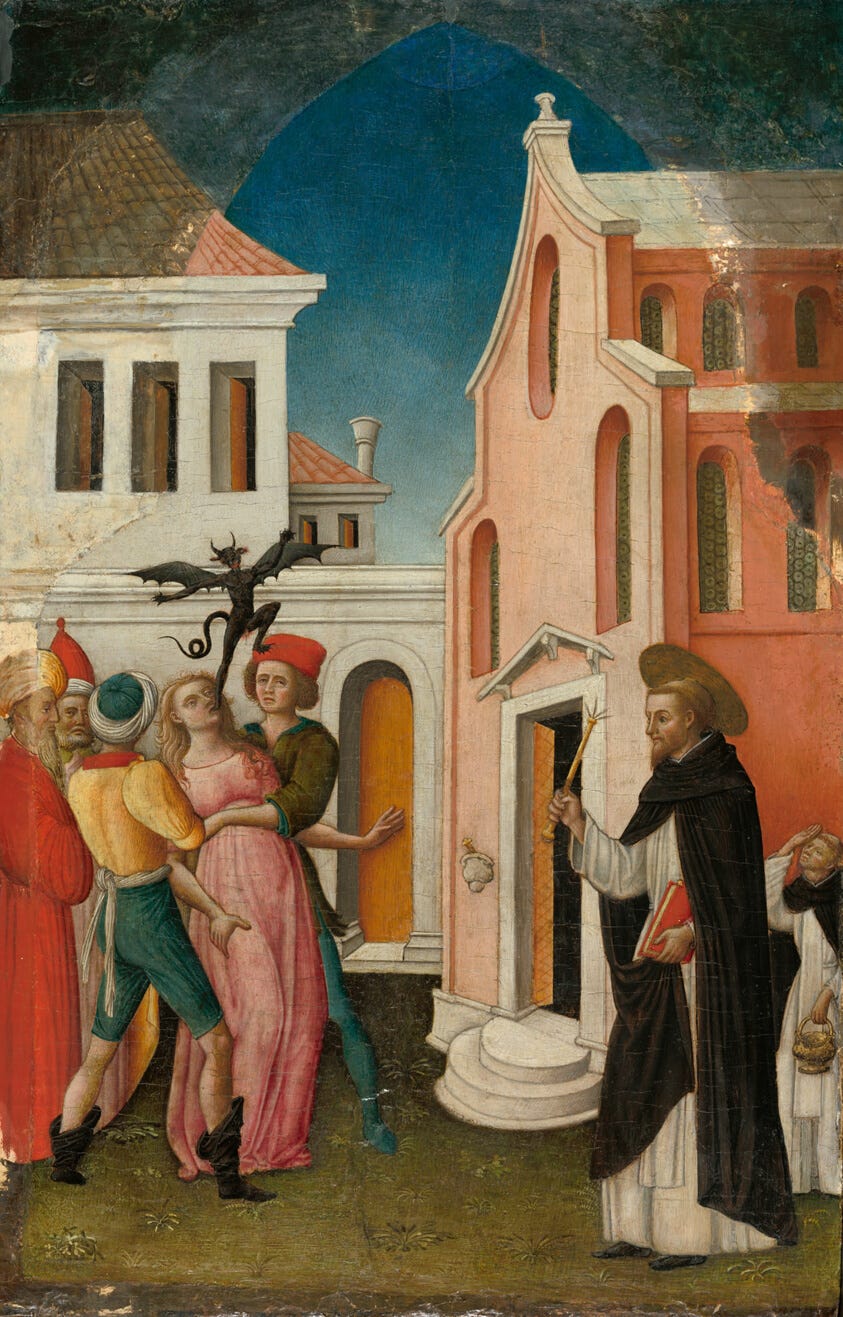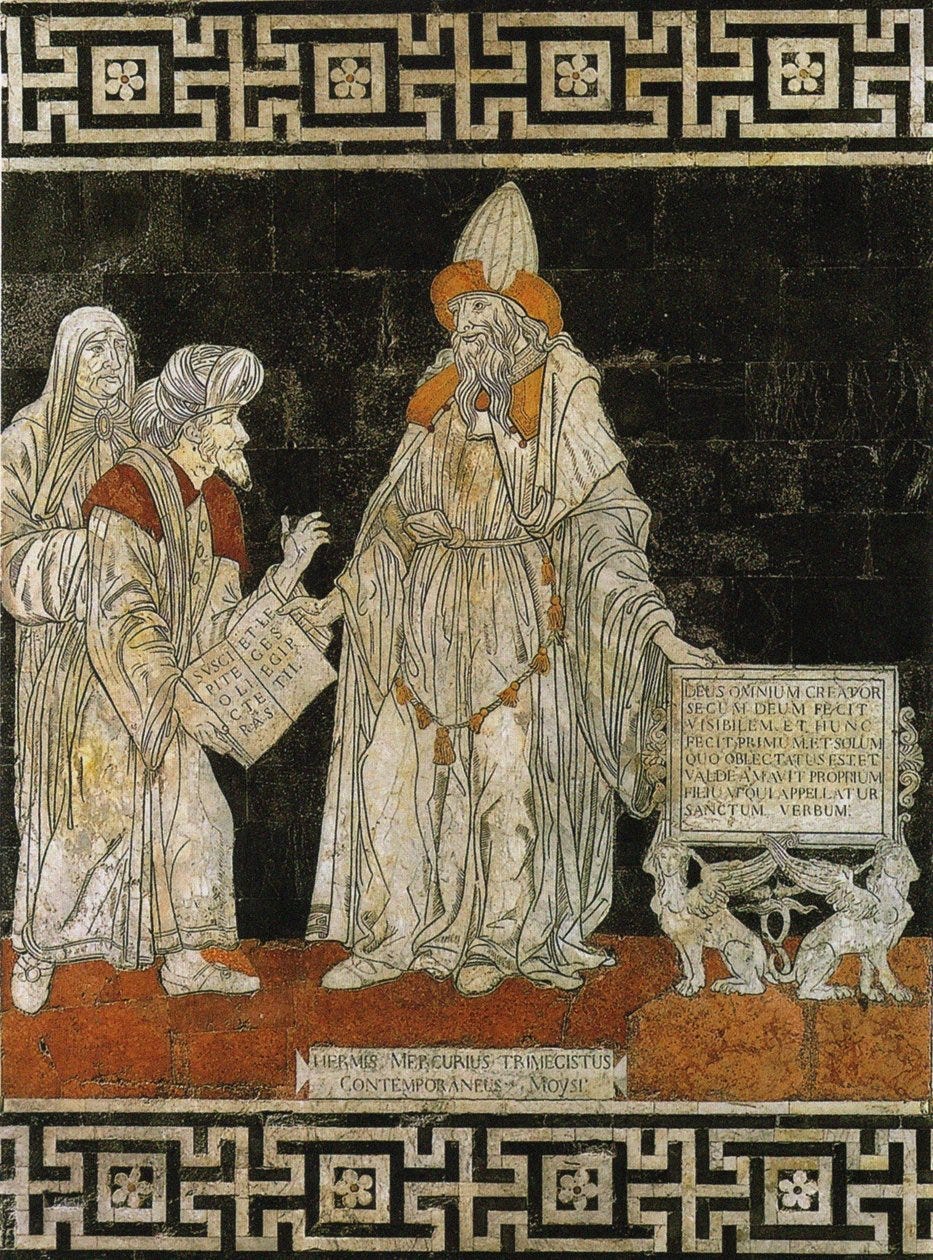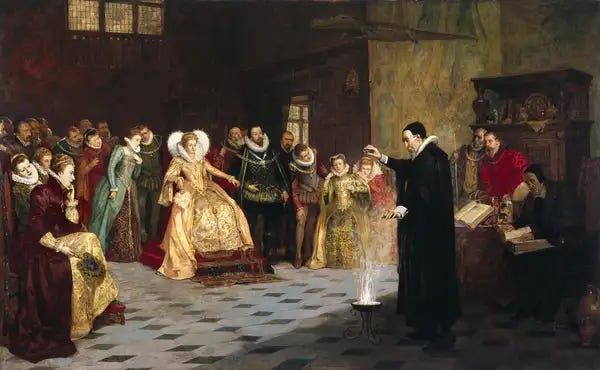The Philosophy of Demonology and the Politics of Occultism
Pierre Le Loyer, Meric Casaubon and John Dee's encounters with Spirits
In the wake of the Reformation, it suddenly became urgent to understand what was really going on with miracles, angels, and demons. Belief in the miraculous and supernatural was one of the chief theological disagreements between Catholics and Protestants: Catholics believed in ghosts and demons and ongoing divine intervention, while Protestants tended not to. Initially this distinction may not have been hard and fast—Luther himself believed fervently in demons—but as the schism developed, belief in the supernatural became a key differentiator. Consequently, the subject attracted increased attention, both from scholars and religious practitioners. If Catholics could demonstrate the reality of demons, or if Protestants could persuade fence-sitters that miracles were impossible (at least after the apostolic age), it would count as a significant blow to the other side.
Luther Confronts his Demons
The conflict over the supernatural might seem superficial, even silly, like an argument among English majors about quantum mechanics: no one knows what they’re talking about. But it was not merely an empty exercise in social differentiation, or what is called by anthropologists “schismogenesis.” If we listen to William James, the mystic experience of miracle and supernatural phenomena is the essence of religion. And indeed, for Catholics, the Protestant rejection of ongoing miracle became an attack on the miracles of Jesus himself. As Carlos Eire writes, for Catholics “the credibility of Christianity itself depended on belief in the continuity of God’s power to perform miracles.” But the Pauline promise of Christianity guaranteed not only religious ecstasy and mysticism, but also universalism and reverence of the poor, the meek, and the weak. Protestants saw the miracles of the saints as part of the scaffolding upholding an unjust, unchristian Church hierarchy, which undermined the promise of universality and humility.
“Saint Michael,” Master of Belmont (1450-1500)
As the need to work out the reality of these phenomena took on new social proportions, demonology became a philosophical trend. The tradition of demonology stretches back into the ancient Jewish mystic tradition and could include the history of Greek daimons as well, which were neither good nor evil but simply semi-divine spirits. In both cases, the reality of demons was typically assumed and the pressing questions involved naming specific demons, describing their agenda, recording spells to summon them, and so forth. To be sure, writers like Aristotle and Cicero had ignored or dismissed belief in demons, but they had not tried rigorously to disprove their existence. In the 16th and 17th centuries, demonology expanded to include scholarly apologias for the demonic tradition, complete with epistemological defenses of the reality of demons, and also skeptical, materialist analyses that attempted to demonstrate the unreality of demons. In some cases, these early modern demonological texts are remarkably modern: their arguments are based more on problems of perception, causality and materialism than appeals to religious faith, and they refer as often to Cicero and Aristotle as to scripture or Augustine.
From the illuminated manuscript “La Livre de la Vigne Nostra Seigneur” (1450)
Pierre le Loyer’s 1605 A Treatise of Specters, Strange Sights, Visions, and Apparitions Appearing Sensibly unto Men is an excellent example. Following impeccable philosophical etiquette, Le Loyer begins with a definition of specters, working through a number of subtle qualifications and distinctions before arriving at his conclusion, and then proceeds to a kind of literature review, weighing the arguments for and against their existence, before dwelling on a diversity of reports. Le Loyer’s definition of the spectral is worthy citing, if only because it succinctly expresses an ambiguity that touches the central problem or paradox all cryptomorphic, supernatural reports. “A specter, or Apparition is an Imagination of a Substance without a bodie, which presenteth sensibly unto men, against the order and course of nature.” With the idea of a “substance without body,” le Loyer brings us back to the problems negotiated between Plato and Aristotle, and raises the problem of how the nonphysical can become physical, or at least phenomenological. But he also raises the problem of psychology in a subtle way. Even at the turn of the 16th century, it was common to assume that if someone sees something impossible like a ghost or demon, it must be a symptom of an distressed psychology. What le Loyer means by “imagination,” he clarifies, is “a motion of the soul, which the sense doth create and engender.” The specter as an idea or image is nothing more than the imagination’s reaction to an encounter with a nonphysical substance. We might say it is, for le Loyer, a hallucination, but not a hallucination caused by internal psychology but instead by this external substance without a body. The imagined thing is not nothing; the specter itself, whatever it is, acts as a cause on the imagination and is therefore somehow ‘sensed’. But the thing that appears as a physical manifestation is caused in turn by the imagination, in response to the nonphysical thing that cannot be perceived in itself. The real thing, a phantom, creates an image of itself in the imagination, but this imagination of the phantom is always only a fantasy. As le Loyer suggests, it is this transition from phantom to fantasy that makes discussion of the spectral so difficult. All reports of such supernatural encounters can be dismissed as fantasies by those who have not encountered something similar themselves because, at one level, they are just fantasies. Le Loyer’s theory of attends to both the immediate veridicality of supernatural experience itself and the apparent silliness of its narrativization and explanation to other people. The specter that appears is real, even if its reality is constituted with the aid of the imagination (nothing Kant wouldn’t suggest).
Le Loyer knows he is writing for an educated audience that had already largely turned against belief in the cryptomorphic. He sounds downright modern in his impatience with dogmatic, materialistic unbelievers:
Others there be… (being great mockers, and incredulous, because they themselves did never happen to see any visions, nor have ever heard or touched any supernatural thing) [who] have been of this opinion that nothing could appear unto men that exceeded or went beyond the course of nature… But how can it possibly be that a man should think without any show of reason, by incredulity and mockery only, to confute and overthrow that which hath been ever of all men, and in all ages, received and admitted.
“St. Peter Martyr Exorcising a Woman Possessed by a Devil,” Antonio Vivarini (1450)
If throughout history educated authorities have acknowledged the reality of demons, then it is sheer arrogance to deny their existence. Le Loyer may have little patience for those who dismiss the possibility of the spectral, but he himself maintains a healthy skepticism about the details. He warns that many are “abused by the force of their imagination” into believing absurdities. He denies, for instance, the possibility of alchemy and exorcism and follows the authority of Aristotle in rejecting divinations in dreams. If nothing else, it is difficult to say le Loyer fails to evaluate the evidence, or is ignorant of natural causes; his discourse clearly delineates the possibility of the spectral within a modern scientific model of nature.
Demonology is one area of the wider field of occult philosophy, which traces its beginnings to the Hebrew king Solomon, revered as a magician in the ancient world, and the Biblical figure Enoch, who supposedly traveled to heaven to meet with God directly. More concretely, though, the occult tradition finds an origin in the Hellenistic Greek philosopher figure of Hermes Trismegistus, a mysterious, possibly apocryphal character who was revered by Augustine and other Catholic theologians as a proto-Christian prophet. According to legend, Hermes Trismegistus was the author of a series of texts on astrology, alchemy, and magic, known collectively as the Hermetica,which offers a syncretic treatment of the systems of magic developed in ancient Greece and Egypt. The Hermetica influenced early Christian Gnostics and clergy (many early popes were practitioners of magic), thrived in Islamic scholarship throughout the medieval period, and became central to Renaissance and early modern occult philosophy through writers like Picco della Mirandola and Heinrich Agrippa. Occultists often claimed knowledge about the specters that appear in inexplicable experiences (the sort of knowledge Aristotle deemed impossible), and unlike levitating Christian saints who became airborne only unintentionally, occultist hoped to manipulate these powers on purpose, toward their own practical ends. In the early modern period, in the service of the Catholic cause and in the spirit of the utilitarianism of an emerging bourgeois society, demons and spirits came to be understood instrumentally.
Hermes Trismegistus, Mosaic in Cathedral of Siena (1488)
Occult philosophy is relevant to our inquiry into demons for two reasons. First, because it illustrates a historical form of semi-rational approach to the cryptomorphic; as we saw in le Loyer, it can offer helpful ways of thinking about such encounters. Second, and contrarily, because the larger failure and overreaching of occult philosophy cast the question of demons as an absurd one, indistinguishable from magic incantations and exorcism—not to be taken seriously. The rise of occult philosophy after the Reformation contributed to the decline in belief in the cryptomorphic: the magicians and astrologers who believed in them were ridiculous revanchist Catholics. If le Loyer’s academic treatment of specters illustrates what a rigorous account of the supernatural might look like, the excesses of occult philosophy can be seen more clearly through the life of the English mathematician, priest, alchemist, seer, and polymath John Dee (1527-1608). Dee and his ilk represent a turning point in the medieval Christian attitude toward the inexplicable: no longer can the miraculous and supernatural merely be a sign of God; it must be mastered and instrumentalized in the search for gold and political advantage. If it cannot be mastered, it will be useless. What Dee’s life shows, above all, is that demonology’s appeal, and its ultimate undoing, was its promise of secret knowledge, which on the one hand made it highly attractive to state authorities—who always seek the most rarified intelligence—and, on the other, given its inability to demonstrate or use this secret knowledge, discredited it entirely.
John Dee was not a fringe figure but was firmly installed within the highest institutions in England, both an intellectual and political authority. It was in part his place in the reigning establishment that made him, and his brand of occultism, a target. He was an exceptional scholar, with degrees from Cambridge and Louvain Universities, and was particularly famed as a mathematician. He claimed to be the first lecturer to publicly teach Euclid’s Elements of Geometry “in any University in Christendom.” Dee’s collected works include volumes on mathematics, maritime navigation, the British colonies, and occult symbology. As a scholar, he received direct support from Henry VIII. Later, he became a regular advisor at the court of Queen Elizabeth I, where his astrological predictions played a significant role in shaping the course of British empire. The stars, he believed, favored the English and he was a staunch advocate of British imperialism and colonization. Indeed, Dee himself is often credited with coining the term “British empire” (although other claimants exist). His renown and political standing demonstrate just how accepted occult, magical practices were among scholars and political leaders in the 16th century. As Glynn Parry, one of Dee’s biographers, writes, “In that almost alien universe Queen Elizabeth I devotes hours to poring over her alchemical manuscripts and then applies their methods in her laboratory, seeking incessantly for the philosopher’s stone that will purify decaying bodies and society alike. In that world the Queen’s most influential advisor, Lord Burghley, pleads for a fragment of the stone to help build a navy… and the Queen’s favourite, Lord Robert Dudley [an ally of Dee’s], believes that Christians can legitimately conjure angels to reveal the political future.”
“John Dee Performing an Experiment Before Queen Elizabeth,” Henry Glindoni (1800)
Dee’s interest in astrology and alchemy certainly seems to have been disinterestedly academic, rather than polemical or partisan. He was not a convinced Catholic but something more like a nondenominational seeker, or opportunist. While enrolled at Louvain University, where Catholic doctrine had recently been restored through bloodshed, Dee publicly swore to reject “the doctrines of Martin Luther and all heretics, in so far as they clash with the teaching of the Catholic Church”—despite the fact that he had recently, as a requirement of graduation from Cambridge, formally rejected the authority of the Pope. It is difficult to know if Dee’s accommodation of rival doctrines constituted an enlightened superiority or if it was a sign of single-minded ambition to power. He was happy to serve the Catholic Queen “Bloody” Mary until her death, and even became an ordained priest (perhaps out of fear—the ceremony was so rushed it required special permission from the diocese), but was equally pleased, if not more so, to be in the employ of Elizabeth, even after she returned the country to the Protestant Church of England. Dee, it would seem, was not a propagandist for the Catholic Church, but only a highly ambitious man with a keen ability to adopt the correct political positions. In Dee, the occultist looked like a yes-man, a lackey to the powerful. For anyone opposed to the political regime he served (and he served them all), Dee and his ilk were evidence of corruption or Satanism.
Certainly, plenty of manipulative opportunists took advantage of the princely caste’s interest in the dark arts—and occultists, like any political class tasked with predicted the future, had all the cohesion of a band of thieves. Dee himself participated in outing occultist pretenders: A favored target was a seer named Vincent Murphy, who Dee derided for practicing non-academic forms of magic, like conjuration with nail clippings and bits of hair. But if Murphy enflamed Dee’s ire, it was likely because Murphy had himself accused Dee of fraud. Their exchange of accusations came to an end when Dee successfully sued to have Murphy imprisoned after it was revealed he had forged letters to corroborate his divinations. Though he pretended to scholarly purity, Dee’s own seeing could take low forms, too. He once tried to win patronage with the promise he could locate buried treasure. This he could not do, however. Nor could he exorcise a demon from his own servant. By his own record, he was wrong in all his specific predictions, while his accurate ones were fairly general and obvious. Beyond his expertise in occult knowledge and his approval by institutional authorities, it’s not clear how Dee achieved credibility as a seer at all. Would this not seem to be a case of a mad, corrupt aristocracy attempting to justify its beliefs with the plainly delusional ravings of an hubristic scholar who thinks he possess the secrets of the universe?
John Dee’s Obsidian Mirror
Later in life, Dee had his own doubts. Dee remained a true believer, both in the spirit world itself and his own powers to calculate it, but by 1581, at the age of 54, he was discouraged by his progress in divine understanding. “Oh God almighty,” he writes in a monograph, “I have from my youth desired and prayed unto thee for pure and sound wisdom and understanding of some of thy truth.” Yet, he laments, he had only found “some ynkling, gyms or beame” of it. He began turning to more obscure forms of magic and began entreating God for direct angelic guidance. It seems this desperation provoked something—a sign. Around this time, Dee reported in his diary that at night he was haunted by strange knocking sounds in his chamber, for which there was no obvious material cause. He heard a voice “like the schrich of an owle” coming from within his room, though nothing was there. Then, two months later, he cryptically reported in his diary a vision he encountered in his crystal ball: “I had sight in Crystallo offered me, and I saw.” What he saw, he does not say—an adherent of hermetic silence even in his diaries.
The following year, he began searching for a spirit medium to help him in his quest for angelic contact. The man he found was Edward Kelley, a fellow occultist who had once been convicted of counterfeiting gold in a philosopher’s stone fraud. In his own account of what followed, A True and Faithful Relation of What Passed for Many Years Between John Dee and Some Spirits, Dee claims that he and Kelley successfully summoned a variety of spirits. Using a crystal ball that Dee claimed belonged to early Church Fathers and an obsidian mirror, which has been confirmed to be of Aztec origin, the two tried to converse with the spirits. And, eventually, they did so, contacting the archangels Michael and Raphael and many others. Through their conversations, Dee said the angels taught him their own language, which he dubbed “Enochian.”
“Socrates with Alcidiabes and the Daimonion,” François-Andre Vincent (1776)
Beyond the exotic paraphernalia, their method was highly suspect. After summoning spirits through prayer and “oratory” (presumably incantations), Kelley would perceive visions in Dee’s “show-stones” and communicate the angel’s messages to Dee, who would speak to them through Kelley. Modern historians regard Kelley as a con man who fed Dee the stories he wanted to hear, many of which resembled those found in earlier occultist literature—particularly the work of Agrippa. Yet, Dee reports that Kelley often pleaded with him to end their summoning, fearing their interlocutors were demonic (“suspecting the creatures might be no good creatures”), and was sometimes viscerally afraid of the “grisely countenances of the monsters” he saw in the show-stones. All of this could easily have been part of a cunning act, a ploy by Kelley. Still, the obvious explanation meets a few trickier obstacles. In at least one instance, Dee communicated with the spirits in Greek, a language that Kelley, at least to Dee’s knowledge, did not understand; in Greek they warned that Kelley would “overthrown this work” and betray him. In another instance, Dee reports that he himself witnessed “a spiritual creature,” a young maiden named Madini, who suddenly appeared, while Dee orated his incantations, and moved about his study between piles of books. In this encounter, Dee reinforces the interpretation of spirits offered by le Loyer. He writes that he is able to see Madini “only with my imagination,” implying not that his experience is a fantasy but that it is rather a symbolization of the nonphysical. In a subsequent visitation, an angel in his crystal ball warns Dee that “Angels of themselves… do take forms not according to any proportion in imagination, but according to the discreet and appliable will both of him, and of the thing wherein they are administrators.” An angel cannot be imagined in itself but is presented in the imagination according to the peculiarities of the medium—i.e. the desires or will of the witness, the tools of the summoner (crystal ball), or the substrate in which they appear to the witness (night sky, underbrush, etc.). Whether Kelley merely exploited Dee’s desperation to make angelic contact and invented the whole illusion, or if Dee and Kelley did experience such cryptomorphic encounters, whether by the occult logic of enchanted objects and incantations, or else some supernatural coincidence or tricksterism, will have to come down to a matter of choice, a choice that might, by reason or faith, be legitimately made in either direction. Dee may have been compromised by his political associations in the upheaval of 16th century England, but his interpretation of the spectral and his reports of inexplicable experiences might still be taken on their own.
Whatever Dee experienced, over the following century his occult philosophy would come to be regarded first as demonic and second of all false. This progression from the spiritual to the demonic to the false is underwritten by a deep political and social concern.
In the 1655 edition of A True and Faithful Relation, the scholar Meric Casaubon offers a remarkably even-handed analysis of Dee’s work and indicates a shift in scholarly attitude toward the supernatural. Casaubon, renowned as a translator, produced the first English edition of Marcus Aurelius’ Confessions and wrote extensively on religious faith and enthusiasm, notably in his book Of Credulity and Incredulity. “The world is full of imposture,” he writes in the preface to Dee’s manuscript. “To know this, to observe it in all Trades, in all Professions, in all ranks and degrees of men, is to know the world, and that is to be wise.” And acknowledging the special, categorical difficulty of supernatural claims, he adds, “how much more caution do we need in those things that are so much above Sense, and in some respects contrary to Sense (and that is Spirits) that we be not deceived?” Casaubon considered himself an Aristotelian and he betrays a charming impatience with Dee’s enthusiasm for his inexplicable experiences. But he also takes pains to distinguish himself from the skeptics who would deny the existence of a spiritual realm all together. “As in other things of the world, so in matters of Spirits and Apparitions, though lyable to much error and imposture… there may be reality of truth and certainty discernable unto them [who] will take the pains to search things to the bottom.” But if spirits are real for Casaubon, they are not worthy of intellectual pursuit. To Casaubon, it is clear that if Dee’s account can be believed at all, the spirits he raised were demonic. He compares Dee to the Roman god of wine, Bacchus, and Mahomet, the prophet of Islam, “by whom, as instruments, evil spirits, by God’s permission, brought great alterations in government and wrought much mischief and villany among Men and Women.” He is “much of the opinion that these spirits had great hopes of Dr. Dee” as well.
Scottish Woodcut (1591)
For Casaubon, all cryptomorphic experience is demonic. This attitude represents a bridge between the Catholic ambivalence toward the cryptomorphic, in which such phenomena might be divine or demonic, and the characteristically modern attitude that such phenomena don’t exist. In Casuabon we see the cryptomorphic identified with the demonic, and the demonic identified with error—an identification that will be strengthened in Descartes, as we’ll see below, and is still with us in our interpretation of hallucination as error. “Can any man,” he writes of Dee, “think they follow God in this [kind of study], who would have all things done in order, and is not a God of Confusion (1 Cor. 14. 33, 40), when all they do tends to nothing else but disorder and confusion?” Dee’s experiences, like all miraculous, anomalous and cryptomorphic encounters, only lead to confusion and mystification, and therefore cannot be signs of God, who is manifest in truth and understanding. Demonology is nothing but a great error in thought—because it is demonic, not Godly.
“Twin Peaks,” Episode 29, David Lynch (1991)
Casaubon’s preface is interesting for another reason, already noted: it hints at the political and social dimensions of reports and inquiries like Dee’s. As Casaubon implies, social-political authority is constituted through knowledge of the natural order, and speculation about the supernatural thrives in the absence of strong authority. By itself, then, it poses a challenge to authority. Of Dee, he writes, “I know not what these men can say for themselves, except it be that they are resolved to make use of the liberty of the times to please their humor.” As the hegemony of the Catholic church cracked and scientific advances questioned the authority of the Aristotelian understanding of nature, there is no doubt a radical kind of liberty was felt by those who judged the virtues of the old paradigm against the promises of the new. They floated suspended between the two claims to authority, free to deliberate about the nature of reality for themselves, to become sovereign authorities in their own rite. And in this radical freedom to authorize reality by throwing oneself behind one claim or another, the most radical might stake their own claim to authority, or much worse, disavow authority all together. Casaubon fears that dwelling on the mystery of the cryptomorphic will lead to further political instability and anarchy. “We have reason to praise God,” Casaubon says, that Dee did not become another Bacchus or, God forbid, another Mohammad, or else “England might have been overrun with anabaptism.” The danger of the supernatural, the nature of its devilry, was to undermine the very possibility of authority. If the rupture in European society gave itself to demonic speculation, in order to reestablish order demonology must be consigned again to Aristotelian ambivalence at a minimum. But modernity would push this even further. In Casaubon, the study of apparitions amounts to an error that threatens political stability. For more modern thinkers, like René Descartes and Baruch Spinoza, the moral error of demonology would be interpreted as an epistemological error.

